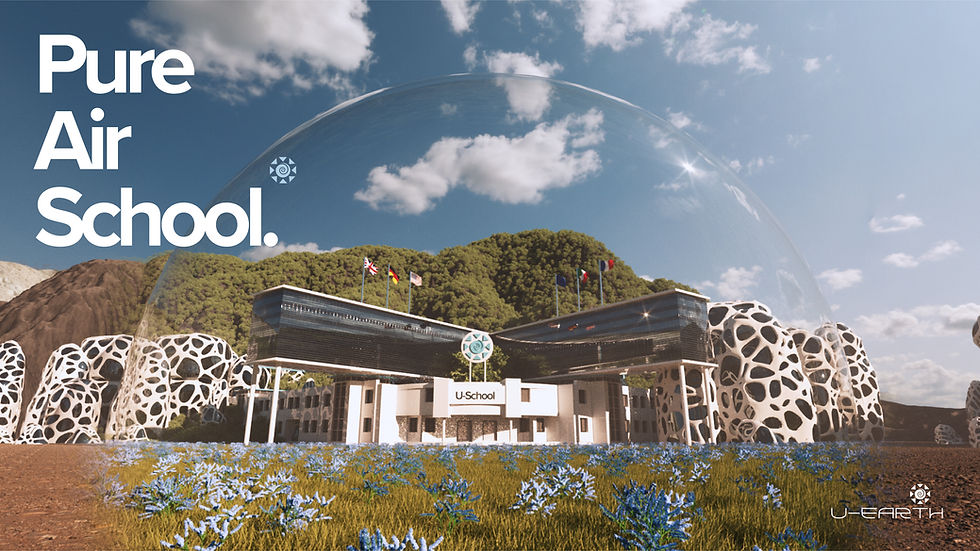In the Air, Unaware - How Pure Air Zones can help Build Anti-Covid Schools
- U-Earth Team
- Jan 7, 2021
- 4 min read
Updated: Jul 3, 2024
It has never been more important to provide a safe environment for our children. As air pollution rises and coronavirus continues to be a concern, how can a school ensure that it remains safe for students as the new term begins?

An Air Pollution Problem that Needs to be Controlled
It is no secret that the UK has an air pollution problem. In 2017, 44 cities had air pollution levels above the recommended WHO guidelines and the government highlighted poor air quality as the largest environmental risk to public health, causing chronic conditions that can lead to reduced life expectancy with 1 in 8 UK deaths suggested to be linked to environmental pollution, and the coroner delivering a landmark ruling in December 2020 that air pollution caused one London schoolgirl’s death.
The problem isn’t limited to the UK either; air pollution across Europe is an ongoing concern with 90% of city dwellers exposed to pollutants at concentrations higher than the air quality levels deemed harmful to health. The levels of PM 2.5 are estimated to reduce life expectancy by up to 8 months within the EU, with Ceglie Massapica in Southern Italy having the highest levels of air pollution throughout the entirety of the EU.
Although many think of pollution as an outdoor problem – perhaps imagining third-world city smog – the truth is very different. It is not possible to keep the contaminants of vehicles and industry at the door when you step inside a home, office or school, and the result is a circulation of unclean air.
The situation is made worse with an average building capable of producing volatile organic compounds (VOCs); alongside the harmful chemicals from outside, these environments also harbour their own internal pollution, circulating unknowingly amongst inhabitants.
Where does school pollution come from?
In schools, pollutants can emerge from everyday objects - food cooked in kitchens, deodorants and cleaning products, to refurbishments - painting a corridor or replacing a carpet. As can be seen and read in recent news coverage, viruses and bacteria also contribute to school pollution levels with teachers and the general population concerned that COVID-19 will spread more easily as schools reopen after the Christmas holidays.
The result of pollution within schools is that VOCs can be 2-5 times higher than the recommended maximum level and up to 1000 times higher after certain activities, such as paint stripping. Since only 10% of our time is spent outside, indoor air pollution is a very real problem, and as arguments rage over whether school buildings are currently safe amidst the pandemic, it’s important to consider how to enhance the safety of the educational environment going forward.
It is unlikely that schools of the future will allow people to move through hermetically-sealed bubbles, each individual possessing their own personal air source, so how can the education sector combat these difficulties? How can they do their best by the children placed into their care and ensure the safety of the wider world throughout the pandemic?
Thankfully there are a number of solutions that can be implemented to give parents and teachers peace of mind and ensure that when it comes to students’ health and safety, their local schools aren’t left behind.
Be aware and be vigilant
Small changes are the easiest to put into practice. By constantly thinking about air quality and spreading the word, students and teachers can do their utmost to stay safe within school grounds.
Replace log-burning fires
Perhaps only applicable to a few, log-burning fires are one of the biggest contributors to a drop in air quality. Recent research last month suggested that wood burners triple harmful indoor air pollution.
The school may or may not be similar to Hogwarts. If it is, replacing a traditional fireplace with a bio fire – where ethanol is burned rather than wood – delivers a smoke-free, eco-friendly solution.
Consider an air purifier
In China, these miniature marvels are commonplace with clean air marketed as an affordable luxury. As such, rather than plant a tree, consider planting an air purifier. They can be plugged directly into a wall and can remove viruses, bacteria and VOCs from their surrounding environment allowing cleaner air for all.
U-Earth offers a bespoke Pure Air Zone solution where one air purifying bioreactor is equivalent to the power of 276 oak trees and can 'eat' up to 3.5kg of contaminants a day. Probably best not to allow the students to climb on it though. The solution also includes sensors, a monitor and the U-Alert protocol.
Air can essentially go wherever but in this day and age it pays to offer a solution to what many see as an invisible, growing problem. Ensuring cleaner air throughout a school is a small price to pay when compared to the cost to students’ health and productivity.
By offering cleaner air, staff will stay happier, students can perform better and attain improved grades, and the school can be seen as a glimpse of a brighter, healthier future.
If you are interested in an air purification solution and helping your local school become a Pure Air Zone, please click here.
A version of this article originally appeared in Education Today magazine, October 2020.

Commentaires